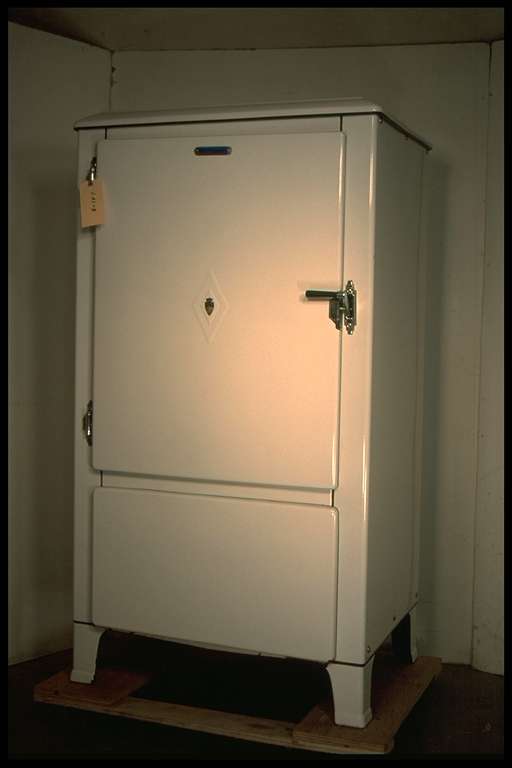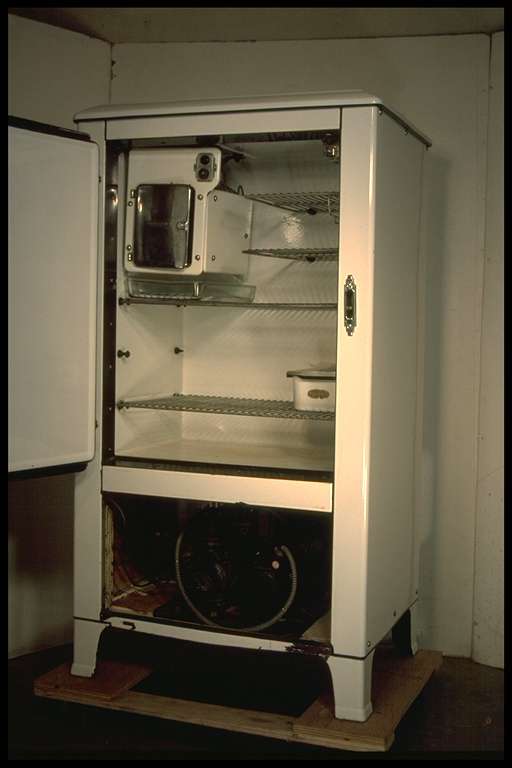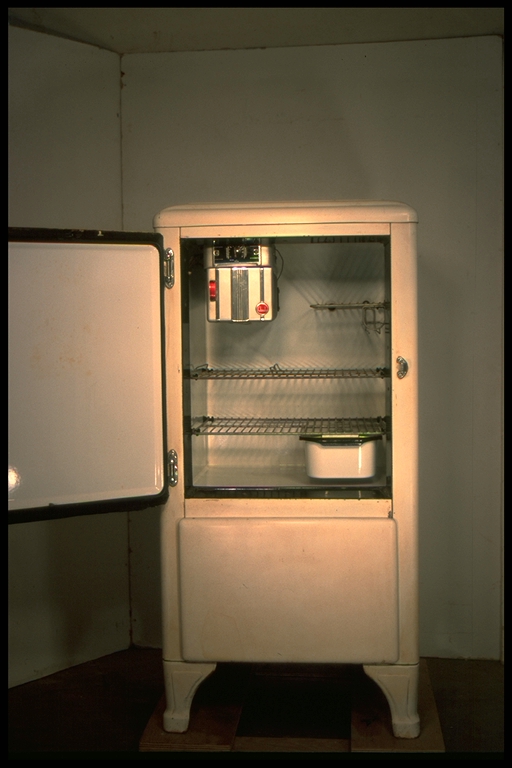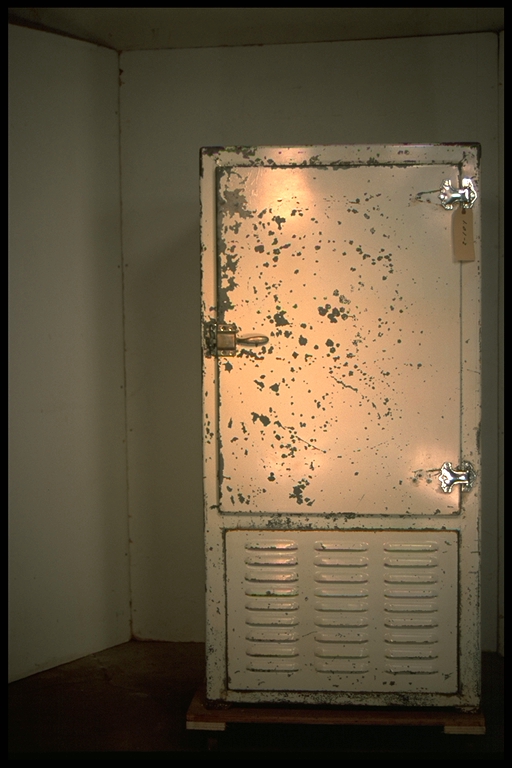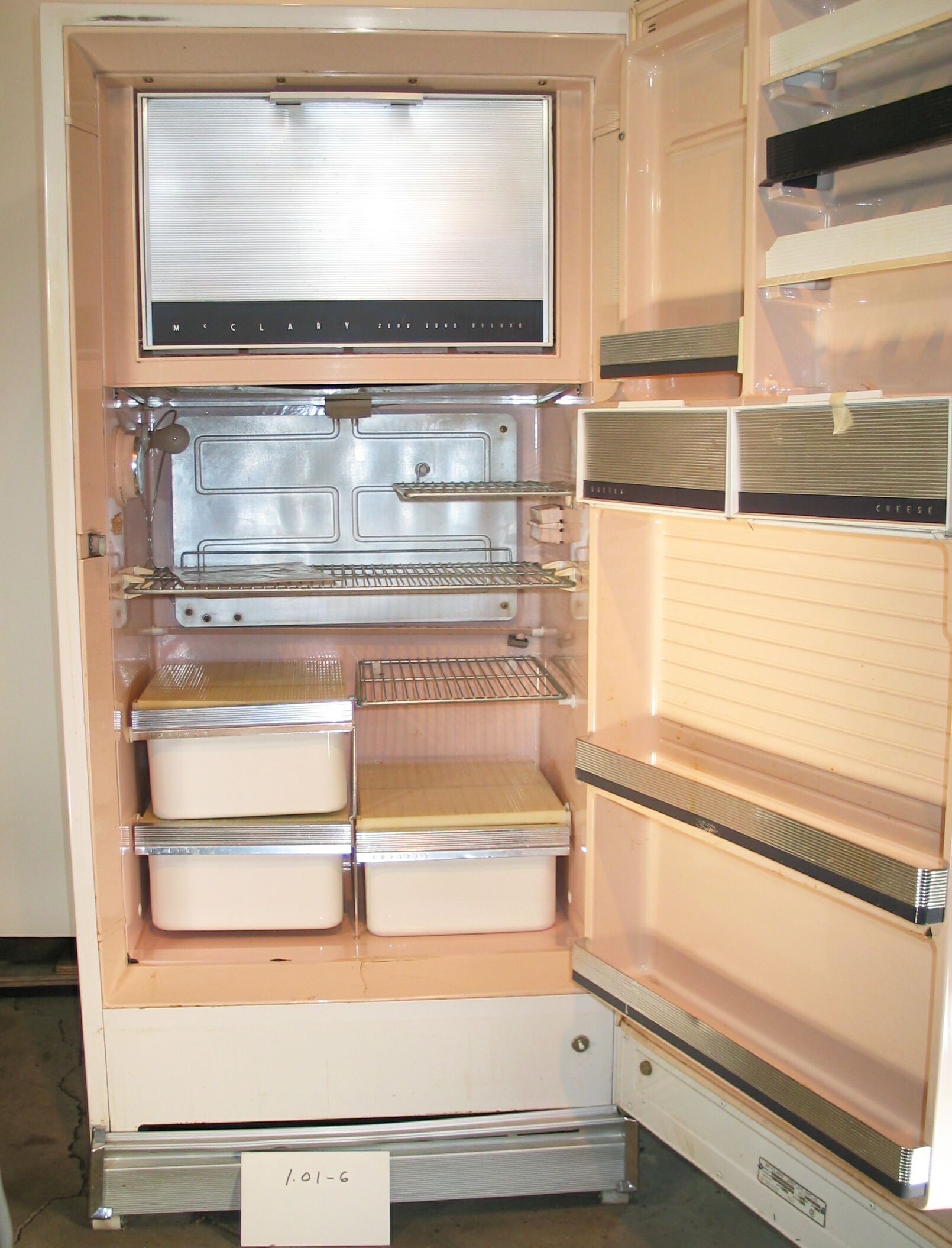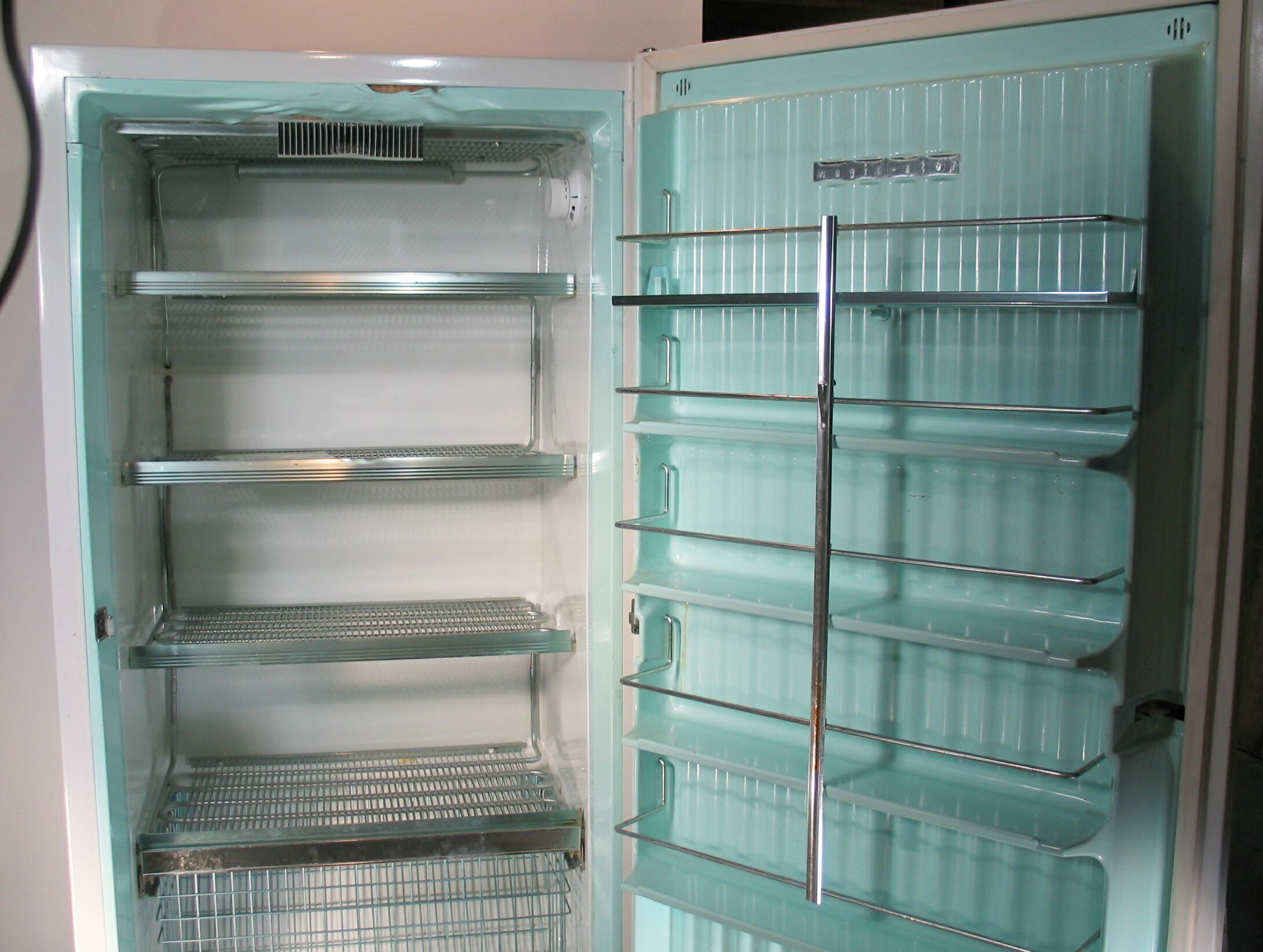1.01-3: Kelvinator 1931 Cabinet Refrigerator
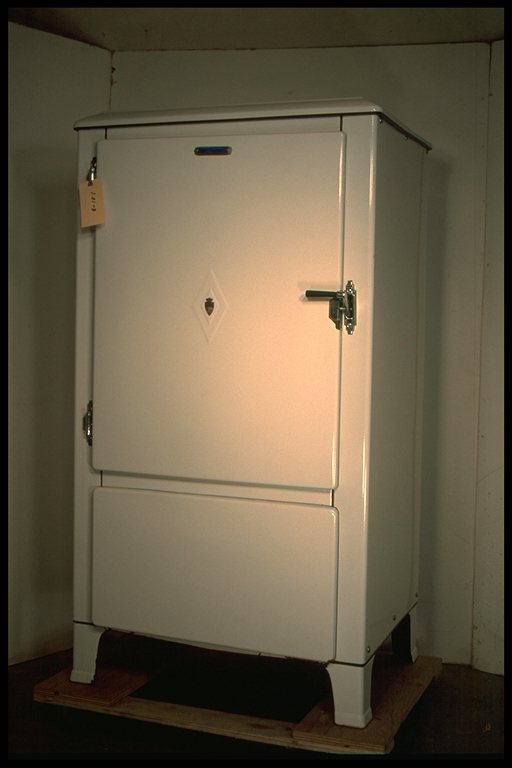
| HHCC Accession No. 2003.002 | HHCC Classification Code: 1.01-3 |
|---|
Description:
Household, Eight Cubic Cabinet Kelvinator Refrigerator In All Porcelain Cabinet, Kelvinator,1931
Group:
1.01 Unitary Refrig and A/C Equipment and Systems - Household Cabinet Refrigerators
Make:
Kelvinator
Manufacturer:
Kelvinator of Canada, London Ontario
Model:
PK7 See Note #1
Serial No.:
See Note #1
Size:
31x25x59’
Weight:
Circa:
1931
Rating:
Very rare, - unusual example of the genre, exhibit quality
Patent Date/Number:
Provenance:
From York County (York Region) Ontario, once a rich agricultural hinterlands, attracting early settlement in the last years of the 18th century. Located on the north slopes of the Oak Ridges Moraine, within 20 miles of Toronto, the County would also attract early ex-urban development, to be come a wealthy market place for the emerging household and consumer technologies of the early and mid 20th century. This artifact was discovered in the 1950’s in the used stock of T. H. Oliver, Refrigeration and Electric Sales and Service, Aurora, Ontario, an early worker in the field of agricultural, industrial and consumer technology.
Type and Design:
Operating system: compression refrigeration type, theoretical Carnot cycle. Design: unitary design and construction with: insulated refrigerated cabinet, evaporator and expansion valve, and self-contained refrigerant condensing unit, electric motor driven.
Refrigerating Unit (Condensing Unit): Type: Self-contained condensing unit with belt driven compressor, single-phase electric motor, and air-cooled condenser. Design: Non-hermetic design, steel base with coil spring mounting Evaporator: Type: Low-side float, flooded evaporator. Design: Ice maker, multiple tray in porcelain steel
Flow control: Type: low-side float Design:
Construction:
Cabinet: cabinet with inside light and automatic, door operated switch, in white porcelain and chrome
Condensing Unit: Kelvinator, spring mounted, belt-drive condensing unit, Model CB532, Serial 2333OC, equipped for remote mounting (See Ref. 1.3 , P.73, see for full specifications) -Kelvinator, low-side float, flooded, 4 tray evaporator
Material:
Wooden frame, steel panels and all porcelain finish inside and out.
Special Features:
Sliding crispers, egg racks, butter keepers interior cabinet lights and new easy to operate latching systems were the vanguard of many new amenities which would henceforth drive the field, along with ‘modern’ new styling looks. - An added cabinet feature (not shown in the specification sheet) is an ‘elbow’ operated door latch.
Accessories:
Capacities:
Performance Characteristics:
Operation:
Control and Regulation:
Targeted Market Segment:
The deluxe PK7 was symbolic of Kelvinator’s bid for the high-end market. With gleaming white exterior porcelain finish (which it carries to this day with scarcely a chip), it was the ‘Cadillac’ of the industry. It was priced by Kelvinator in their February 23, 1932 price list at a whopping $355.00 (See Ref. 1.2, Section 21). This represents a replacement consumer cost in 1996 dollars of $3,447.00 (Statistics Canada, Cansim Matrix 7440). The opportunity cost of such an investment was approaching that of an automobile of the times.
Consumer Acceptance:
Merchandising:
Market Price:
Technological Significance:
Unitary Refrigeration Equipment: The idea of a unitary piece of refrigeration or air conditioning equipment was a significant one in its own right, one that had to wait its time. The scientists, engineers and inventors in the early years of the 20th century were intrigued and obsessed with the power of the technology and of its possible market potential. What they saw was the newly discovered principles of physics and heat engines - following, for example, the early works of Carnot, Faraday, Kelvin, and the later work of Perkins, Larsen and Carrier, to name a few.
They understood the promise of the technology for the public good, not to say its consumer sales potential. Early engineering work advanced on a multiple fronts with development of compressors, heat exchangers, valves and piping variously strung together in configurations that would be found to work, but only after much experimentation.
The arrival of unitary equipment, all those parts organised into a single whole, a single unit of construction, a ‘black box’, that could be offered to the consumer market was a significant technological and cultural event. Technologically the refrigerator would need to be seen to be safe, reliable, maintainable and useful. As well, in order to attract the development capital needed, it must be seen as potentially saleable and affordable, contributing to life’s needs and desires. Its socio- cultural and economic significance was marked, for it would change much. As Canadians we would quickly come enjoy potentially healthier lives, expect new levels of comfort and convenience, with a broader, safer, more diverse and enjoyable diet.
Canadians would quickly come to think of their day differently, for the day would be defined and punctuated in different ways than ever before, as a result of the introduction of modern, electric, household appliances, of which refrigerators, freezers and room air conditioners would be a central part, by the mid 20th century
J. M Larsen produced a manually operated household refrigerator of sorts in 1913, but it was not until 1918 that the Kelvinator Company marketed the first automatic, unitary refrigerator for the home. In that year, it is reported to have sold sixty-seven machines. (See Note 1) The historic artifacts in Group 1.00, Unitary Equipment, including significant samplings the early work of Kelvinator of Canada, provide a rare view of the evolution of unitary refrigeration and air conditioning applications, as they evolved in Canada in the first half of the 20th century.
For those formative years, the artifacts in this Group, 1.00, are typical of the offerings of the Canadian refrigeration and air conditioning industry. They personified the applications found in the homes, farms and commercial premises of the period for, those that could afford life’s new amenities of comfort, convenience and privilege.
This Specimen: The embryonic and early developmental years behind it, Kelvinator’s PK7 marked the beginning of its early growth years in Canada. By the mid 1930’s, in spite of the depression, electric refrigerator had made its mark on the consumer public. By now the electric refrigerator was more stable and quieter in operation with higher speed compressors and spring mounted condensing units and above all new modern styling befitting the period.
Industrial Significance:
The electric refrigerator was, all of a sudden, more attractive in appearance, with gleaming, easy to clean surfaces and fully rounded corners. It clearly had come into its own with its own unique aesthetic.
No longer did it appear to the public as a thinly disguised ice box, an image which the public was, by now, quite happy to leave behind. As symbolised here, the PK7 was an important transition point in the development of the industry. Manufactures could see that their continued success would require more than merely well built, efficient and reliable refrigerating machines.
As an increasing number of manufacturers entered the field, the battle for market share was on; customer appeal and features were to become the key to customer sales. One authoritative source reported in 1933 specifications for 24 national manufacturers of household compression cycle refrigerators along with 5 absorption system manufacturers, including Elecrolux of Evansville Ind (See Ref. No. 3.1).
Socio-economic Significance:
Socio-cultural Significance:
Donor:
G. Leslie Oliver, The T. H. Oliver HVACR Collection
HHCC Storage Location:
Tracking:
Bibliographic References:
Kelvinator Service Manual
Notes:
T.H Oliver Collection code 1.101-3 Note #1 model and serial numbers: - Cabinet: Kelvinator cabinet Model PK7, Serial unknown, a special issue of the K7 in all porcelain finish outside as well as inside (See Ref. 1.2, Sect. 1, P. 3283, specification sheet issued Nov. 12 1931) Condensing Unit: Kelvinator Model CB532, Serial 2333OC, see Ref. 1.3, p, 73 for specifications
Related Reports:
Thumb-Nail Profile see THOC doc. OC9908B
